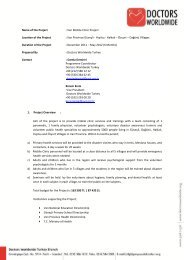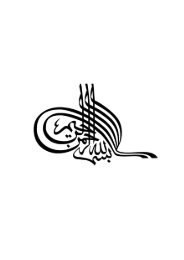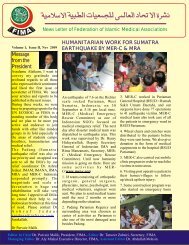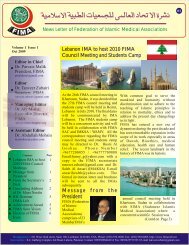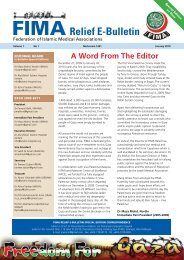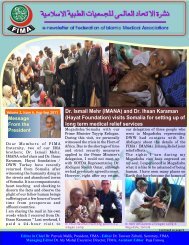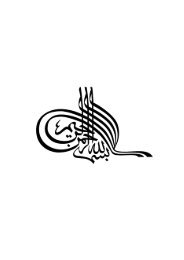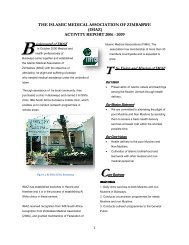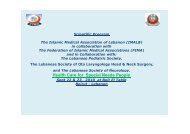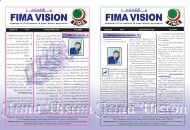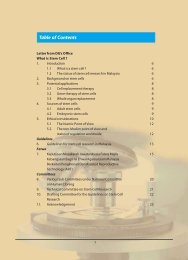FIMA Year Book 2009 - Federation of Islamic Medical Associations
FIMA Year Book 2009 - Federation of Islamic Medical Associations
FIMA Year Book 2009 - Federation of Islamic Medical Associations
You also want an ePaper? Increase the reach of your titles
YUMPU automatically turns print PDFs into web optimized ePapers that Google loves.
Ethics <strong>of</strong> Clinical Researchmethods, sources <strong>of</strong> funding, andpotential risks <strong>of</strong> the study. Theyshould be informed about their rightto abstain from participation or towithdraw from the study without anyreprisal. For a research subject whois a minor or legally incompetent, theinvestigator must obtain informedconsent from the legal guardian. Theseand other vulnerable groups shouldnot be included in research unless it isnecessary to promote the health <strong>of</strong> theparticular group from which they arerecruited.In the United States, the US NationalCommission for the Protection <strong>of</strong>Human Subjects <strong>of</strong> Biomedical Researchwas created in 1974 and produced theBelmont Report in 1979 which distilledprinciples <strong>of</strong> ethics related to research. (18)It addresses boundaries between medicalpractice and research; basic ethicalprinciples such as respect for persons,beneficence, and justice; and informedconsent, assessment <strong>of</strong> risks and benefits,and selection <strong>of</strong> subjects.Another international organization,The Council for InternationalOrganizations <strong>of</strong> <strong>Medical</strong> Sciences(CIOMS), was founded in 1949 underthe auspices <strong>of</strong> the World HealthOrganization (WHO) and the UnitedNations Educational Scientific CulturalOrganization (UNESCO). CIOMS,in association with WHO undertookits work on the ethics <strong>of</strong> biomedicalresearch in the 1970s . It producedguidelines to enable the effectiveapplication <strong>of</strong> the ethical principles setforth in the Declaration <strong>of</strong> Helsinki,particularly in developing countries.Their first report was published in1982. Following that, there were majordevelopments such as the outbreak <strong>of</strong>the HIV/AIDS pandemic and proposalsto undergo large scale experiments withvaccines and medications. There werealso rapid advances in biotechnologyand an increase in multinational fieldtrials involving vulnerable populationsin developing countries. Thesedevelopments raised new ethical issuesand in 1996 CIOMS updated its reportand published International EthicalGuidelines for Biomedical Researchinvolving Human Subjects and updatedit in 2002. This consisted <strong>of</strong> a statement<strong>of</strong> general ethics, a preamble and 21guidelines. (19)The <strong>Islamic</strong> Viewpoint on CIOMSGuidelinesThe <strong>Islamic</strong> Organization <strong>of</strong> <strong>Medical</strong>Sciences (IOMS), based in Kuwait,translated this document into Arabic.It was then reviewed by a scholar<strong>of</strong> <strong>Islamic</strong> Jurisprudence principles.The document along with the latter’scomments were discussed by a group <strong>of</strong>Muslim scholars, physicians, includingmyself, and other individuals withinterest in ethics and the law. The<strong>Islamic</strong> viewpoint on each <strong>of</strong> theseguidelines was studied in depth bythis group and discussed in a threeday conference held in Cairo, Egypt,December 2004. The results <strong>of</strong> thesedeliberations were published as theInternational Ethical Guidelines for<strong>FIMA</strong> <strong>Year</strong><strong>Book</strong> <strong>2009</strong>140




